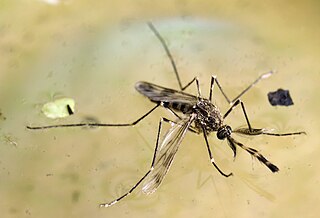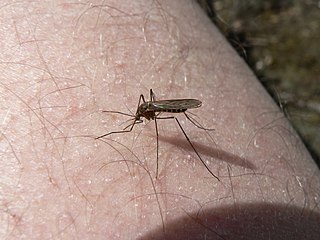
Mosquitoes are members of a group of almost 3,600 species of small flies within the family Culicidae. The word "mosquito" is Spanish and Portuguese for "little fly". Mosquitoes have a slender segmented body, one pair of wings, one pair of halteres, three pairs of long hair-like legs, and elongated mouthparts.

Culiseta is a genus of mosquitoes. Most Culiseta species are cold-adapted, and only occur in warmer climates during the colder parts of the year or at higher elevations where temperatures are lower. Species found in Southern California are larger than most mosquitoes species, specifically Cs. inornata, Cs. particeps, and Cs. incidens. These species are found throughout the year in Southern California and feed on several vertebrate species, such as birds, livestock, rodents, reptiles, and humans. The larvae of most species are found bogs, marshes, ponds, streams, ditches, and rock pools, but an African species occurs in tree holes ("phytotelmata"), a common eastern Palaearctic species occurs in water wells and rock pools, and several Australian species occur under ground. Little is known about the blood-feeding habits of females. Most species feed on birds and mammals, but a few feed on reptiles. Several species attack domestic animals and occasionally humans, and some species are pollinators.

Culex restuans is a species of mosquito known to occur in Canada, the United States, Mexico, Guatemala, and Honduras. It is a disease vector for St. Louis encephalitis and West Nile virus. In 2013 West Nile Virus positive specimens were collected in Southern California.

Aedes vexans, the inland floodwater mosquito or tomguito, is a cosmopolitan and common pest mosquito. This species has been collected in southern California.

Culex tarsalis, also known as Western Encephalitis Mosquito, is a mosquito species that appears in southern California. The species has black and white banding on the legs.

Culex quinquefasciatus, commonly known as the southern house mosquito, is a medium-sized mosquito found in tropical and subtropical regions of the world. It is a vector of Wuchereria bancrofti, avian malaria, and arboviruses including St. Louis encephalitis virus, Western equine encephalitis virus, Zika virus and West Nile virus. It is taxonomically regarded as a member of the Culex pipiens species complex. Its genome was sequenced in 2010, and was shown to have 18,883 protein-coding genes.
Culex erythrothorax is a mosquito species that appears in Southern California. It is also known as the Tule Mosquito due to its preference for breeding in tule plants. The species has a brownish-orange color. It is a confirmed vector of West Nile virus.
Jamestown Canyon encephalitis is an infectious disease caused by the Jamestown Canyon virus, an orthobunyavirus of the California serogroup. It is mainly spread during the summer by different mosquito species in the United States and Canada.
Culiseta novaezealandiae is a species of mosquito. It is endemic to New Zealand. It is found in Southland and Otago. This species was first described by J. S. Pillai in 1966 using specimens collected at Tahakopa. The habitat of this species in its larval stage is coastal broadleaf swamp. It has been hypothesised that the hosts of C. novaezealandiae are birds. This mosquito species is regarded as being unlikely to be an arbovirus vector.

Anopheles freeborni, commonly known as the western malaria mosquito, is a species of mosquito in the family Culicidae. It is typically found in the western United States and Canada. Adults are brown to black, with yellow-brown hairs and gray-brown stripes on the thorax. Their scaly wings have four dark spots, which are less distinct in the male.
Culiseta melanura, the black-tailed mosquito, is a species of mosquito in the family Culicidae. Since adult female Cs. melanura primarily take their blood meals from birds, they are responsible for transmitting eastern equine encephalitis virus between birds. Humans, horses, and other mammals become infected with eastern equine encephalitis virus when other mosquito species besides Cs. melanura, such as Aedes, Coquillettidia, and Culex species take blood meals first from infected birds and then later take blood meals from mammals, transferring the virus to these hosts.

Culiseta inornata, the winter marsh mosquito, or the Unadorned American Cool Weather Mosquito is a species of mosquito in the family Culicidae. This species is found in southern California.

Culiseta impatiens is a species of mosquito in the family Culicidae.
Culiseta minnesotae is a species of mosquito in the family Culicidae.

Anopheles franciscanus is a species of mosquito in the family Culicidae. This species has been collected in southern California.
Culex stigmatasoma is a mosquito species that appears in Southern California, Oregon, and Texas. It is a confirmed vector of West Nile virus.
Culex thriambus is a mosquito species that appears in the southwestern United States, including Southern California, Texas, as well as in Mexico. It is a confirmed vector of West Nile virus.
Ernestine Hogan Basham Thurman (1920–1987) was an American entomologist and researcher, focusing on mosquitoes and vector control. In 1951 she was the first woman sent by the United States to Thailand to establish a malaria control program.
Culiseta particeps is a species of mosquito in the family Culicidae. It is found along the West coast of the United States including Southern California, Arizona as well as Mexico and Guatemala. Cs. particeps is not a known vector of human pathogens.
Anopheles hermsi is a species of mosquito in the family Culicidae. It is a known vector of Plasmodium vivax malaria. An. hermsi have been collected in Southern California.









